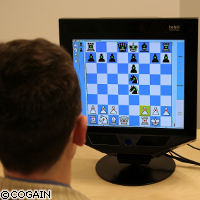Gaming-with-gaze gives people with disabilities an edge
Europeans are taking virtual technology to new heights - and the COGAIN ('Communication by gaze interaction') project is a fine example. Supported by the 'Information Society Technologies' (IST) Thematic area of the Sixth Framework Programme (FP6) with EUR 2.9 million in funding, COGAIN has developed technology that enables gamers to control game functions with only their eyes. People with serious motor disabilities will benefit from this latest innovation. The 'gaming-with-gaze' software is publicly available at no extra cost, according to the COGAIN partners, who are working at coordinating efforts from developers of new communications tools for people with disabilities, using gaze and eye-tracking technology. 'For people suffering from conditions such as cerebral palsy, motor neurone disease (MND) or so-called locked in syndromes, being able to move around and interact in a virtual environment is a 'truly liberating experience',' explained Professor Howell Istance from De Montfort University in the UK. 'Until now, gaze-tracking technology has mainly been used for typing with visual keyboards, for browsing the Web, and [for] other text-based applications,' added Professor Istance, a computer scientist who helped develop the software. 'We have taken it to an entirely new level by using eye movements to control an avatar in a virtual environment, allowing people with disabilities to appear and interact just like able-bodied people if they wish.' According to the researchers, the gaming-with-gaze software runs together with eye trackers currently available on the market. The eye trackers use cameras to monitor users' eye movements as they gaze at a computer screen. Eye movements of able-bodied gamers were evaluated by the developers in order to set up a visual heat map that would trigger commands depending on where users look, the team said. The various eye movement patterns are converted into 'gaze gestures' which are used to activate movement or action commands. 'In the current set-up, we have programmed 12 gesture sequences to activate different keyboard or mouse events,' Professor Istance told ICT Results. 'Many more commands are possible but the total number is limited by the users' memory and the need to differentiate between when someone wants to input a command and when they are just looking at the screen.' The team said the gaming-with-gaze software should make the avatars of people with disabilities nearly indistinguishable in their behaviour and abilities from those of able-bodied people in online games and environments. 'It could be life changing for the large number of paralysed people whose only means of communicating is with their eyes,' said Dr Aulikki Hyrskykari of the University of Tampere in Finland. 'Obviously there will be limitations to what users with disabilities can do - such as not being able to perform several actions simultaneously - but they can choose what activities they participate in. That is a choice they did not have before.'
Countries
United Kingdom



